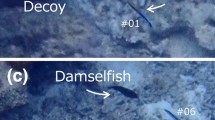Abstract
The risk of predation generally entails alterations in prey behaviour or morphology, but only a few organisms, such as caddisfly larvae, are able to undergo rapid morphological changes mediated by behaviour. Here I explore whether predatory fish (Squalius pyrenaicus) and crayfish (Procambarus clarkii) provoke similar responses from caddisfly larvae (Calamoceras marsupus) in terms of the speed of case construction and the use of different materials differing in their protective value (sticks > leaves; tough leaves > soft leaves). Laboratory experiments demonstrated that C. marsupus larvae were able to recognise both types of predators, and responded to them by constructing a case within hours. Moreover, predation risk motivated the use of more protective materials for case construction when compared to controls. The response to the crayfish was faster than that to the fish, which could be related to differences in the nature and predation efficiency of different predators (i.e. crayfish may be more efficient at predating on leaf litter-dwelling invertebrates than fish, which live in the water column). This study provides novel evidence about the expression of morphological defences mediated by behavioural responses to predation risk, and demonstrates that the speed of case construction and its resulting protection level can vary depending on predator nature.



Similar content being viewed by others
References
Boyero L, Pearson RG (2006) Intraspecific interference in a tropical shredder guild. Mar Freshw Res 2006:201–206
Boyero L, Valladolid M, Arauzo M (2005) Dynamics of invertebrate benthic communities and drift in a regulated river of central Spain. Int Rev Hydrobiol 90:392–411
Boyero L, Rincón PA, Bosch J (2006) Case selection by a limnephilid caddisfly [Potamophylax latipennis (Curtis)] in response to different predators. Behav Ecol Sociobiol 59:364–372
Boyero L, Rincón PA, Pearson RG (2008) Effects of a predatory fish on a tropical detritus-based food web. Ecol Res 23:649–655
Briffa M, Rundle SD, Fryer A (2008) Comparing the strength of behavioural plasticity and consistency across situations: animal personalities in the hermit crab Pagurus bernhardus. Proc R Soc Lond B 275:1305–1311
Cruz MJ, Rebelo R (2007) Colonization of freshwater habitats by an introduced crayfish, Procambarus clarkii, in Southwest Iberian Peninsula. Hydrobiologia 575:191–201
Culp JM, Scrimgeour GJ (1993) Size-dependent diel foraging periodicity of a mayfly grazer in streams with and without fish. Oikos 68:242–250
Gil-Sánchez JM, Alba-Tercedor J (2002) Ecology of the native and introduced crayfishes Austropotamobius pallipes and Procambarus clarkii in southern Spain and implications for conservation of the native species. Biol Conserv 105:75–80
Gómez-Mestre I, Díaz-Paniagua C (2011) Invasive predatory crayfish do not trigger inducible defences in tadpoles. Proc R Soc B. doi:10.1098/rspb.2010.2762
Hazlett BA (1981) The behavioral ecology of hermit crabs. Annu Rev Ecol Syst 12:1–22
Hoverman JT, Auld JR, Relyea RA (2005) Putting prey back together again: integrating predator-induced behavior, morphology, and life history. Oecologia 144:481–491
McIntyre PB, Baldwin S, Flecker AS (2004) Effects of behavioral and morphological plasticity on risk of predation in a neotropical tadpole. Oecologia 141:130–138
Otto C (1987) Behavioural adaptations by Agrypnia pagetana (Trichoptera) larvae to cases of different value. Oikos 50:191–196
Otto C (2000) Cost and benefit from shield cases in caddis larvae. Hydrobiologia 436:35–40
Otto C, Johansson A (1995) Why do some caddis larvae in running waters construct heavy, bulky cases? Anim Behav 49:473–478
Otto C, Svensson BS (1980) The significance of case material selection for the survival of caddis larvae. J Anim Ecol 49:855–865
Parkyn SM, Collier KJ, Hicks BJ (2001) New Zealand stream crayfish: functional omnivores but trophic predators? Freshw Biol 46:641–652
Relyea RA (2001) Morphological and behavioral plasticity of larval anurans in response to different predators. Ecology 82:523–540
Steiner UK, Pfeiffer T (2007) Optimizing time and resource allocation trade-offs for investment into morphological and behavioral defence. Am Nat 169:118–129
Stevens DJ, Hansell MH, Freel JA, Monaghan P (1999) Developmental trade-offs in caddis flies: increased investment in larval defence alters adult resource allocation. Proc R Soc Lond B 266:1049–1054
Williams DD, Tavares AF, Bryant E (1987) Respiratory device or camouflage? A case for the caddisfly. Oikos 50:42–52
Acknowledgements
R. de la Paz helped in the field, C. Fernández-Delgado identified the fish species, J. Bosch helped with statistics, and R. G. Pearson provided useful comments on the manuscript. Financial support was provided by a Ramón y Cajal Grant and Project # CGL2010-16285 from the Spanish Ministry for Science and Innovation.
Author information
Authors and Affiliations
Corresponding author
About this article
Cite this article
Boyero, L. Expression of a behaviourally mediated morphology in response to different predators. Ecol Res 26, 1065–1070 (2011). https://doi.org/10.1007/s11284-011-0856-x
Received:
Accepted:
Published:
Issue Date:
DOI: https://doi.org/10.1007/s11284-011-0856-x




